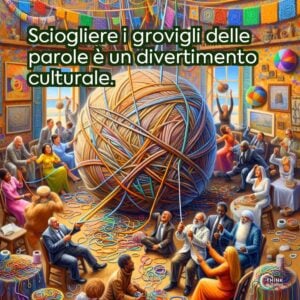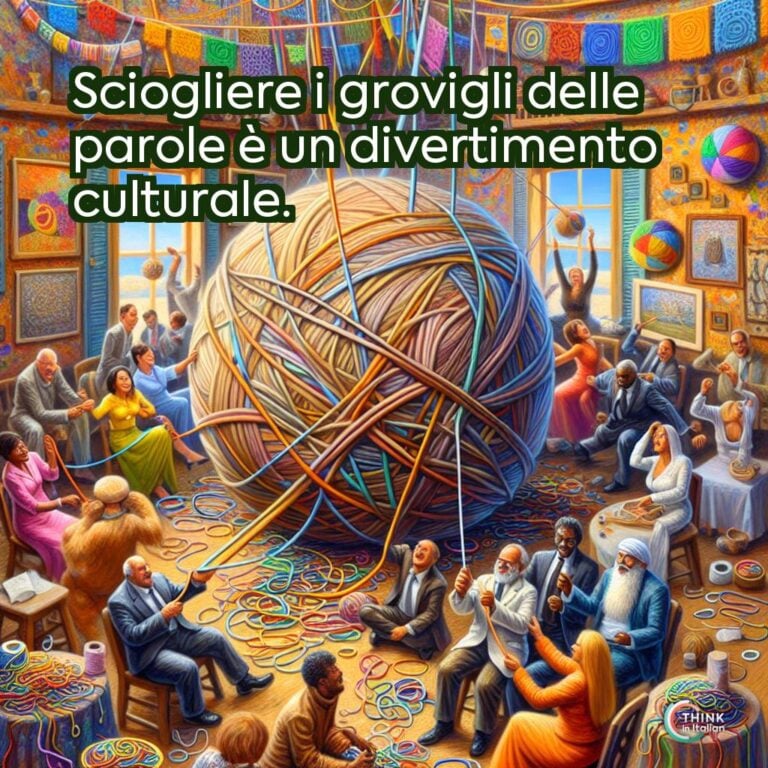Italian Riddles
Italy’s linguistic tradition goes beyond its beautiful words. The playful side of Italian comes alive with its indovinelli (riddles) and scioglilingua (tongue twisters) which carry centuries of history, humor, and regional diversity.
Regardless of the reason why you are learning Italian, riddles and tongue twisters are a fascinating way to connect with the language.
Riddles have been a cornerstone of Italian folklore, passed down through generations as a form of entertainment, education, and bonding, blending humor, wit, and moral lessons.
This thought-provoking mix encapsulates Italian culture’s playful yet reflective nature, and gives you a window into Italian’s humor. Let me guide you through the cultural, educational, and entertaining aspects of these treasures.
Riddles in Italian
Challenge yourself with these riddles, and find the answers at the end of the paragraph!
Una corda di cinque metri è attaccata a un cavallo. Il cavallo è distante 7 metri da una pila di fieno. Come fa il cavallo a raggiungere la paglia?
A five-meter rope is tied to a horse. The horse is 7 meters from a pile of hay. How can the horse reach the straw?
Perché chi vive in Canada non può essere sepolto in Alaska?
Why can’t those who live in Canada be buried in Alaska?
Un contadino ha 9 mucche. Muoiono tutte tranne 3. Quante ne rimangono vive?
A farmer has 9 cows. They all die except 3. How many are left alive?
Un gruppo di paleontologi in Siberia rinviene i corpi di un uomo e una donna ibernati nel ghiaccio, perfettamente conservati. Sono sicuri di aver trovato Adamo ed Eva. Come fanno ad essere così certi?
A group of paleontologists in Siberia discovers the bodies of a man and a woman frozen in ice, perfectly preserved. They are certain they have found Adam and Eve. How can they be so sure?
Ci sono due gemelli. Uno mente sempre, l’altro dice sempre la verità. Come scopri chi è chi?
There are two twins. One always lies, and the other always tells the truth. How do you find out who’s who?
Cos’è sempre di fronte a te ma non puoi vederlo?
What is always in front of you but you can’t see it?
Lo butti quando lo usi e lo tiri fuori quando non serve. Cos’è?
You throw it in when you use it, and you pull it out when you don’t need it. What is it?
È tuo, ma lo usano gli altri più di te. Cos’è?
It’s yours, but others use it more than you do. What is it?
Ha tanti denti ma non morde. Cos’è?
It has many teeth, but it doesn’t bite. What is it?
Più è caldo, più è fresco. Cos’è?
The warmer it is, the fresher it is. What is it?
Answers:
- The rope isn’t tied to anything, so the horse can freely reach the straw.
- Because they’re not dead!
- 3.
- They don’t have navels.
- Ask one twin what the other would say. The liar will give a false answer, revealing the truth.
- Il futuro (the future).
- L’ancora (the anchor).
- Il tuo nome (your name).
- Il pettine (the comb).
- Il pane (the bread). This riddle makes use of a pun because fresco in Italian can mean both fresh and cool.
Tongue Twisters in Italian
Italian tongue twisters are crafted to test and improve pronunciation, fluency, and enunciation. Try these classic tongue twisters:
Sopra la panca la capra campa; sotto la panca la capra crepa.
Above the bench, the goat lives; beneath the bench, the goat dies.
Trentatré trentini entrarono a Trento, tutti e trentatré trotterellando.
Thirty-three people from Trentino came to Trento, all thirty-three of them trotting.
Andiamo a navigar con nove navi nuove, ma una delle nove nuove navi non vuole navigar.
We go sailing with nine new ships, but one of the nine new ships doesn’t want to sail.
Apelle, figlio di Apollo, fece una palla di pelle di pollo e tutti i pesci vennero a galla, per vedere la palla di pelle di pollo fatta da Apelle, figlio di Apollo.
Apelle, son of Apollo, made a ball of chicken skin, and all the fish rose to the surface to see the chicken skin ball made by Apelle, son of Apollo.
The Playful Soul of Italian Culture
Both riddles and tongue twisters embody Italy’s playful spirit. They are much more than linguistic exercises: they’re cultural treasures that reveal Italy’s history, humor, and diversity.
They reflect a love for wit, humor, and the joy of language, as well as the genuine tendency for self-irony Italians have. So, why not give these puzzles a try?
Whether you’re a language learner or simply a lover of Italian tradition, they’re a delightful way to engage with the language and its playful charm.






